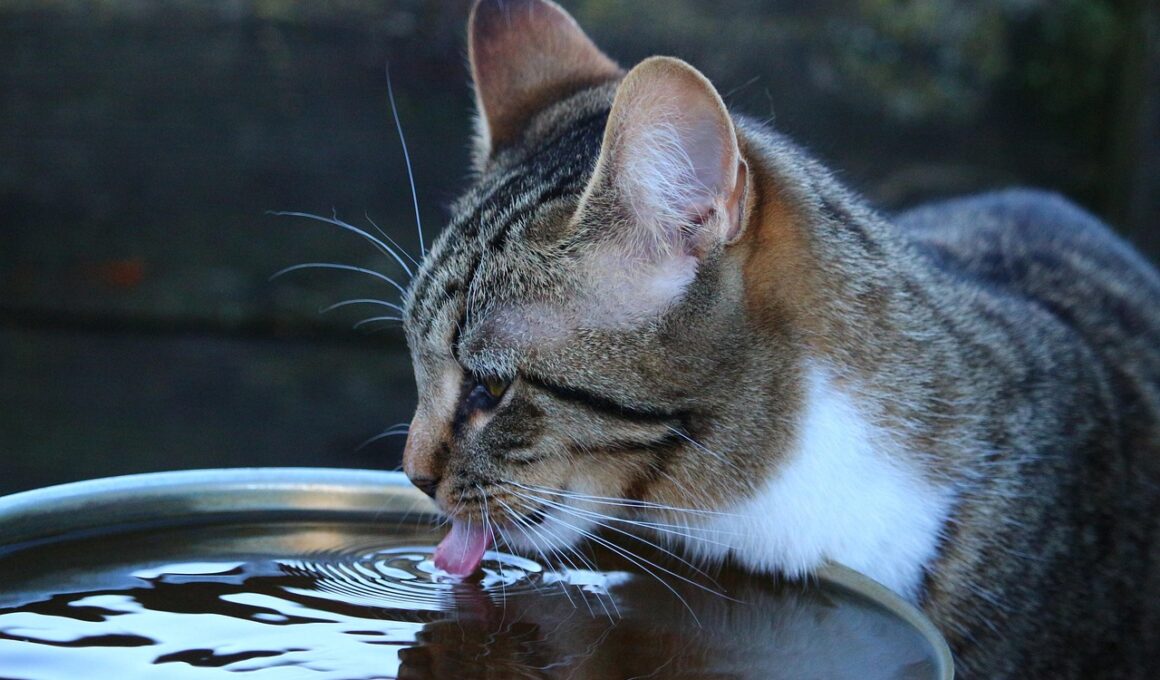Avoiding Common Mistakes When Using Water Training Tools on Cats
Water training tools can be incredibly useful when trying to train your cat to enjoy water. However, there are numerous mistakes that pet owners often make during this process. One major issue is the lack of gradual introduction. Start by allowing your cat to familiarize themselves with the water environment. Instead of plunging them directly into water, try using a shallow bowl or a damp washcloth. It’s crucial to create a positive experience for your cat to establish a foundation of comfort. Moreover, using inappropriate types of tools can deter even the best-intentioned owner. Products designed for larger pets or those intended for dogs may not suit cats well. Make sure to choose water training tools that are specifically designed for felines. Pay attention to size, texture, and safety. Additionally, remember that patience is key. Cats can be stubborn, and forcing them into water without their willingness can result in negative associations. Be prepared for setbacks and adjust your approach accordingly, making every effort to keep the training sessions light-hearted and engaging. Positive reinforcement will always help build trust between you and your feline companion.
The environment where you conduct your water training sessions plays a significant role in your cat’s comfort level. Ensure that the area is calm and free from distractions that could induce anxiety. Too much noise or fast movements can freak out your cat, making them resistant to water training. In selecting your timing, aim for moments when your cat is relaxed and more receptive. Consider using enticing toys to help coax them into learning how to enjoy the water. Introducing the water gradually through play can also promote good experiences. For instance, sprinkling water with a spray bottle while they play can help them get accustomed to the sensation without overwhelming them. Pay attention to how your cat reacts to avoid overwhelming them. It may also help to invite other friendly cats who enjoy water into the training, allowing them to model positive behaviors. Always approach the training process with empathy; if your cat resists, don’t push them. It’s essential to proceed at a pace that is comfortable for your cat rather than strictly adhering to any timeline set by you. Doing so fosters a safe space for learning and adventure.
Overlooking Safety Precautions
Safety should always come first when considering water training tools for your cat. Not only must the equipment be designed for feline use, but the training area should also be secure. Avoid slippery surfaces where your cat might lose their footing and make sure that the water is shallow enough to prevent drowning. Regular supervision during training sessions is crucial, ensuring your cat does not go astray or encounter risks that could lead to accidents. You might consider investing in flotation devices or specific tools designed to keep them afloat should they unexpectedly find themselves in deeper water. Furthermore, always monitor the water temperature; cats can be incredibly sensitive to extremes. Ensure it’s comfortable, as water that’s too cold or hot can deter your cat’s interest. Providing escape routes or utilizing a non-slippery mat can also instill confidence in your pet. Testing the tools before your cat uses them is a good practice, ensuring everything functions correctly. Your diligence in establishing a safe water training environment will greatly enhance your cat’s comfort level.
Reinforcing the idea of proper introduction techniques cannot be stressed enough. Many owners mistakenly dive straight into rigorous training schedules, which may not yield results immediately. Instead, aim for incremental exposure and ensure that the experience remains enjoyable. If your cat becomes frightened or refuses to cooperate, it’s essential to step back and reassess your methods. Cats, like any other animals, have unique personalities, and what works for one may not suit another. Personalizing your approach will yield the best results. Observe their body language; a relaxed cat will often signal interest, while a wary one may indicate distress. Keeping the sessions to shorter time frames will help maintain their focus while also fostering a comfortable pace for the training. Celebrate small victories along the way, providing plenty of praise and treats to reward their willingness. Creating a fun and adventurous atmosphere can drastically improve the overall success rate of your water training journey. Remember, consistent efforts can lead to significant improvements in your cat’s attitude toward water, turning training into an exciting bonding experience.
Common Misunderstandings
There are several misunderstandings surrounding water training tools that can lead to frustrating experiences for both cats and their owners. One prevalent misconception is that all cats inherently dislike water. Although many cats might not enjoy getting wet, some breeds, such as the Maine Coon or Bengal, have shown an affinity for water. Don’t assume your cat won’t enjoy it until you have properly explored their potential for aquatic fun. Furthermore, many owners feel that water training should be completed in a few sessions, which is rarely the case. It’s a gradual process needing ongoing commitment and adaptability. If you’re not willing to adjust your strategy based on your cat’s reactions, you risk scaring them away from future attempts altogether. Instead, view each session as an opportunity to learn what works best for your specific situation. Additionally, mixing too many techniques or tools can confuse them further. Stick to a few trusted methods before introducing anything new, ensuring clarity and consistency. Keeping it simple allows your cat to progress without overwhelming them.
Another common mistake is not using positive reinforcement effectively during training sessions. Negative associations can develop quickly if owners inadvertently punish their cats for resistance or apprehension. Instead, focus on rewarding decisive actions, such as showing curiosity or stepping closer to the water. Always have their favorite treats handy to entice them into trying new experiences. By utilizing positive affirmation, you cultivate an atmosphere of trust, helping your cat feel secure in their surroundings. Incorporate short, engaging activities rather than prolonged sessions to keep your cat interested and motivated. If your cat enjoys certain games or toys, use them during training to blend playtime into lessons, making the experience even more appealing. Timed interactive sessions further promote eagerness, reducing the chances of distraction or boredom. Also, sharing your successes with other pet owners can highlight your progress and encourage you to keep exploring new techniques while forming a supportive community. Engaging with fellow trainers can provide fresh perspectives on easing your cat into enjoying water activities, fostering shared experiences.
Assessing Your Cat’s Reactions
Regularly assessing your cat’s behaviors and reactions during water training can provide crucial insights into their comfort levels. It’s vital to differentiate between assertive curiosity and genuine fear. A confident cat will typically approach the water, showing signs of interest, while an anxious one may display backing away or hissing. Incorporating a journal can help you document any changes in behavior over time, tracking which techniques yield the best results. Note any indicators that show whether your training strategies effectively improve their comfort and engagement levels. Trying different approaches, such as allowing for more exploration time or varying the duration of activities, may enhance their learning experience. Consistency is equally important; frequent exposure to water conditions your pet to anticipate the training positively. The goal is to transform their perception from fear to fun, which can involve multiple adjustments and observations. If your cat remains hesitant despite your best efforts, it might be worth considering professional training assistance. Ultimately, enhancing their experience will yield better outcomes than a forced approach, filled with frustration. Creating a balanced training plan also encourages fruitful progression.
In conclusion, avoiding common mistakes when using water training tools for cats is fundamental to fostering a successful learning experience. By prioritizing gradual introduction, ensuring safety, and employing positive reinforcement, you will create valuable opportunities for growth. Emphasizing fresh perspectives while collaborating with fellow trainers can unearth new methods to improve your training sessions as you adapt to suit your cat’s individual personalities. Always monitor their reactions closely, tailoring your approach to reinforce trust and enthusiasm. A well-structured training plan that respects your cat’s needs will promote a positive association with water and facilitate lasting enjoyment. By adhering to these tips and practices, you can transform potential challenges into remarkable bonding moments between you and your beloved feline. Remember that persistence pays off, and patience is a virtue when it comes to training your feline friend. Celebrate every little success, as these achievements gather momentum that builds up over time. With dedication, love, and informed practices, you will turn water training into an enriching experience for both you and your cat, opening doors to many wonderful adventures together.


